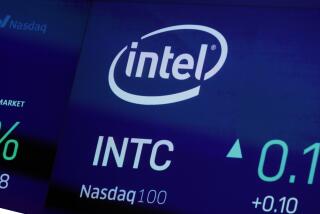Semiconductor Slump Beginning to Take Its Toll on Japanese Firms
- Share via
The worldwide slump in semiconductors is beginning to take its toll on Japanese manufacturers, who have been forced to cut back on capital spending for the first time since they entered the chip business in the early 1970s.
Despite their recent market success against U.S. firms, the Japanese semiconductor makers will slash by 23%, to $2.7 billion, spending on chip-related property, plants and equipment this year, San Jose market researcher Dataquest said Wednesday. In 1984, chip-related spending by those companies totaled $3.5 billion as they came to dominate markets for key categories of high-volume semiconductors.
One of the major Japanese firms, electronic conglomerate Hitachi Ltd., said that its earlier forecast of a 20% decrease in semiconductor spending might have been too optimistic and that its reduction might be closer to 30%. The company said the spending cutbacks won’t affect its recent pledge to increase U.S. investments and jobs, a step intended to ease protectionist pressure.
Plant Capacity
The cutbacks mean that most of the Japanese firms won’t be expanding their manufacturing capacity as much as they intended this year. Japan’s pell-mell spending on plants despite the poor market has been a major complaint of U.S. semiconductor firms, who blame the resulting overcapacity for plummeting prices.
However, analysts said the cutbacks are apparently in response to the bleak semiconductor market rather than to recent U.S. political pressure. And Dataquest said the Japanese companies still collectively will outspend the independent U.S. semiconductor firms this year by more than $300 million.
“I don’t think this represents any moderation in their overall strategy at all,” said Thomas D. Hinkelman, president of the Semiconductor Industry Assn., a U.S. industry group that has registered complaints about trade practices of Japanese competitors.
The retrenchment comes amid a persistent global weakness in demand and prices for semiconductors, largely because of reduced growth in sales of computers, a major chip user. Dataquest also said Wednesday that it was further reducing its forecast for U.S. consumption of semiconductors this year to $9.14 billion, a 31% falloff from 1984. Earlier, Dataquest had foreseen a 20% decline, assuming a second-half improvement that hasn’t materialized.
Lower Profits
The cutbacks in spending by the Japanese range from a 47% plunge at Fujitsu, to $280 million, to about 15% at Matsushita, to $401 million. Two firms, Sanyo and Sharp, plan increases of 25% and 35%, respectively, according to Dataquest.
Hitachi’s semiconductor division was cited by analyst George Haloulakos, of Seattle-based Cable, Howse & Ragen, as the main reason he believed that Hitachi earnings this year will fall by 25% and revenue will be flat.
A Hitachi internal directive to undercut competitors’ prices has touched off a Justice Department investigation and fueled protectionist sentiment in Congress.
Hitachi officials said Wednesday that their reduction in capital spending will be confined to cheap, high-volume chips where supply is greatest and prices weakest.
A Hitachi official said: “If we thought the capacity was needed, we’d be building it.”
The company also said its Irving, Tex., semiconductor assembly plant will phase out production of 64K dynamic random access memory chips later this year and replace it with increased production of more powerful and expensive 256K chips at the plant.






